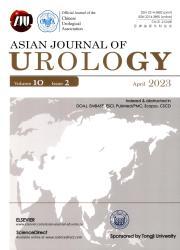机器人辅助腹腔内镜单部位后腹膜肾切除术和膀胱袖带切除术治疗上尿路上皮癌:初步经验
IF 2.4
3区 医学
Q2 UROLOGY & NEPHROLOGY
引用次数: 0
摘要
目的介绍一种改进的机器人辅助腹腔镜单部位腹膜后肾输尿管切除术(RLESS-RNU)联合膀胱袖切除术,并评价其作为一种微创治疗上尿路上皮癌(UTUC)的效果。方法回顾性分析我院(南京医科大学第二附属医院,中国南京)在2020年4月至2021年6月期间接受RLESS-RNU治疗UTUC的15例患者,这些患者来自我们前瞻性维护的机构数据库。da Vinci®Xi系统(Intuitive Surgical, Sunnyvale, CA, USA)用于所有患者的外科手术。对患者的基线人口学特征、病理因素及围手术期细节进行深入分析。详细阐述了完整的手术过程和手术细节。结果15例患者中位年龄为67岁。最终病理显示47%(7/15)的患者pT1或更低,47%(7/15)的患者pT3;1例患者因术前化疗不能进行病理分期。围手术期结果显示,平均手术时间为185(标准差[SD] 23.05) min。套管针初次置入和二次置入的平均时间分别为15.00 (SD 0.85) min和8.00 (SD 0.52) min。估计失血量中位数为55 mL。平均引流管时间和术后住院时间分别为7.50天和11.00天。平均随访24.20个月,无复发生存率为87%。两名患者出现疾病进展:一名患者表现出非肌性浸润性膀胱癌的多灶证据,另一名患者出现全身复发。结论改进的RLESS-RNU技术对UTUC是安全、满意的。本文章由计算机程序翻译,如有差异,请以英文原文为准。
Robot-assisted laparoendoscopic single-site retroperitoneal nephroureterectomy with bladder cuff excision for upper tract urothelial carcinoma: Preliminary experience
Objective
To present a modified technique for robot-assisted laparoendoscopic single-site retroperitoneal nephroureterectomy (RLESS-RNU) with bladder cuff excision and evaluate its effectiveness as a minimally invasive approach for managing upper tract urothelial carcinoma (UTUC).
Methods
Fifteen patients who underwent RLESS-RNU for UTUC between April 2020 and June 2021 were reviewed at our medical institution (The Second Affiliated Hospital of Nanjing Medical University, Nanjing, China), from our prospectively maintained institutional database. The da Vinci® Xi system (Intuitive Surgical, Sunnyvale, CA, USA) was utilized for surgical procedures in all patients. An in-depth analysis was conducted on their baseline demographic characteristics, pathological factors, and perioperative details. The complete surgical process and details are elaborated.
Results
The median age of 15 patients was 67 years. The final pathology demonstrated 47% (7/15) patients with pT1 or lower and 47% (7/15) with pT3; one patient could not undergo pathological staging because of preoperative chemotherapy. The perioperative outcomes revealed that the mean operative time was 185 (standard deviation [SD] 23.05) min. The mean times of the trocar placement for primary and second docking were 15.00 (SD 0.85) min and 8.00 (SD 0.52) min, respectively. The median estimated blood loss was 55 mL. The mean drainage tube duration and postoperative hospital stay were 7.50 days and 11.00 days, respectively. After a mean follow-up period of 24.20 months, the relapse-free survival rate was 87%. Two patients experienced disease progression: one patient exhibited multifocal evidence of non-muscle invasive bladder cancer, and the other patient developed systemic recurrence.
Conclusion
This study demonstrates that the modified technique for RLESS-RNU is safe and satisfactory for UTUC.
求助全文
通过发布文献求助,成功后即可免费获取论文全文。
去求助
来源期刊

Asian Journal of Urology
UROLOGY & NEPHROLOGY-
CiteScore
4.00
自引率
3.80%
发文量
100
审稿时长
4 weeks
期刊介绍:
Asian Journal of Urology (AJUR), launched in October 2014, is an international peer-reviewed Open Access journal jointly founded by Shanghai Association for Science and Technology (SAST) and Second Military Medical University (SMMU). AJUR aims to build a communication platform for international researchers to effectively share scholarly achievements. It focuses on all specialties of urology both scientifically and clinically, with article types widely covering editorials, opinions, perspectives, reviews and mini-reviews, original articles, cases reports, rapid communications, and letters, etc. Fields of particular interest to the journal including, but not limited to: • Surgical oncology • Endourology • Calculi • Female urology • Erectile dysfunction • Infertility • Pediatric urology • Renal transplantation • Reconstructive surgery • Radiology • Pathology • Neurourology.
 求助内容:
求助内容: 应助结果提醒方式:
应助结果提醒方式:


